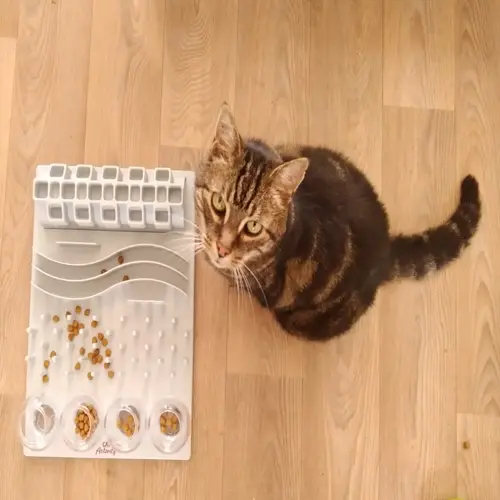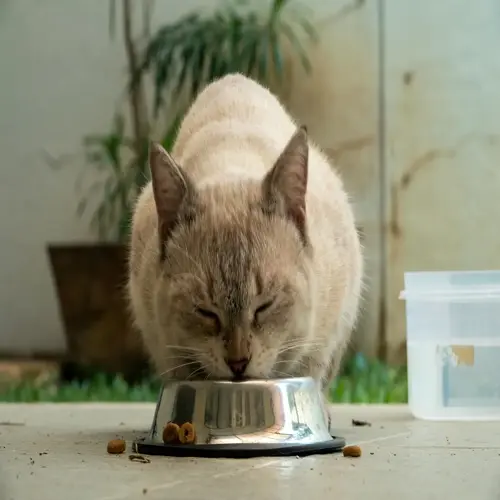Cat Hiding Behavior Explained: Causes and Solutions

Written by
Robert Brown
Reviewed by
Prof. David Walsh, Ph.D.Cats hiding is an important signal for an owner to recognize, as it could indicate stress or illness. Cat owners should take care to understand their cat's hiding behavior.
It's important to develop safe hiding spaces for cats to retreat in if they feel threatened, including hiding boxes and vertical cat perches.
Pheromone diffusers are helpful to have around any areas of the house where you see your cat exhibit anxiety and need calming effects.
It's better to approach a hiding cat passively, without eye contact, until they feel comfortable and safe around a human.
If your cat has been hiding consistently longer than 72 hours, they should be taken to a veterinarian as soon as possible.
Pulling cats out from hiding becomes more traumatic for the cat.
Article Navigation
You notice your cat hiding under the bed again. This hiding behavior may alarm you. It is natural for cats to seek sheltering behavior at times. However, excessive hiding may indicate stress or health problems that need a general diagnosis. I see many anxious cats in my practice. Their owners often feel helpless at first. Learning about this behavior will help your cat.
You may be wondering, Is my cat sick? Have I done something wrong? We will discuss some of the real reasons cats hide. You will discover some realistic solutions to reduce their stress. We will also clarify some of the common misconceptions about cat behavior. All of this knowledge will be of great help to you in supporting your cat.
Using Calming Aids and Enrichment
Pheromone products can help calm your anxious cat. Pheromone diffusers work great for entire rooms. They dispense calming signals continuously. Pheromone sprays are better for specific areas, like carriers or beds. Use these to ease into a targeted area quickly. Both reproduce the effect of natural cat pheromones that indicate safety.
Puzzle feeders tap into your cat's hunting instincts. They require cats to solve challenges to obtain food. This mental stimulation will help reduce stress by allowing them to perform instinctual behaviors. I have seen cats become less anxious when using these daily. This will enable them to redirect their nervous energy into pleasurable things.
Vertical spaces act like observation towers for cats, allowing them to keep an eye on their territory from a safe vantage point. This minimizes hiding behavior, as they feel safe and secure. Install cat trees or wall shelves near windows for optimal viewing. Your cat will gain confidence by looking down upon all items in the room.
Provide interactive play for 15 to 20 minutes (0.25 to 0.33 hours) two times a day. Get wand toys that copy prey movement. This burns off energy while simultaneously building trust. Consistent sessions imply that your cat learns that the environment is safe. This helps him feel more secure over time.
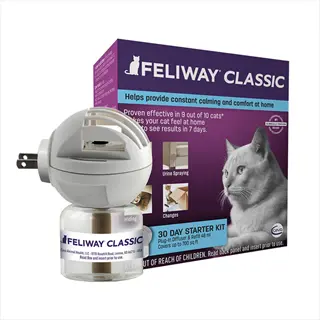
Pheromone Diffusers
- Synthetic feline facial pheromones create security signals similar to natural scent marking behaviors
- Plug-in devices provide continuous coverage for 30 days in 500-700 sq ft (46-65 m²) areas
- Place near hiding spots and entryways where anxiety triggers commonly occur for optimal effect
- Clinical studies show reduced stress behaviors in 80-90% of cases within 2-4 weeks of use
- Brands like Feliway® offer vet-recommended formulas without sedation effects or medication interactions
- Safe for multi-cat households when using multiple diffusers in separate zones throughout the home
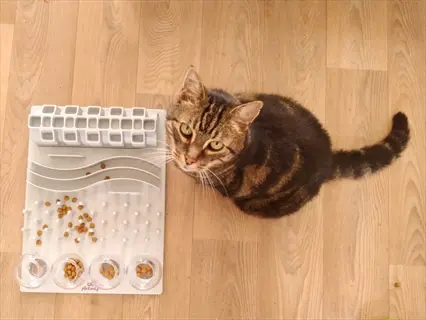
Interactive Puzzle Feeders
- Mental stimulation devices require problem-solving skills to access food rewards and treats
- Slow down eating speed while satisfying natural hunting and foraging instincts effectively
- Start with simple sliding designs and gradually increase difficulty as skills develop over time
- Provide 15-20 minutes (0.25-0.33 hours) of focused cognitive activity that reduces daily anxiety buildup
- Clean weekly with mild soap and warm water to prevent food residue contamination issues
- Rotate different puzzle types weekly to maintain novelty and ongoing feline engagement
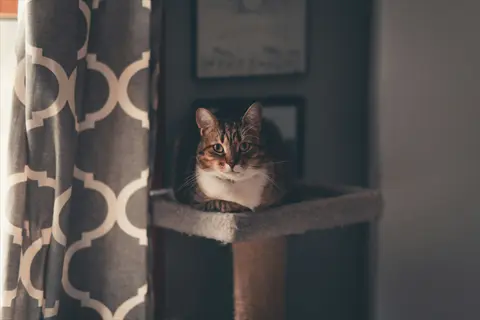
Cat Trees and Shelves
- Vertical spaces satisfy climbing instincts while providing safe observation vantage points
- Place near windows for outdoor viewing entertainment and natural sunlight exposure benefits
- Include scratching posts to combine territory marking behaviors with physical exercise routines
- Minimum height recommendation: 5 feet (1.5 meters) for adult cats to feel secure
- Secure wall-mounted shelves every 12-18 inches (30-45 cm) for accessible climbing paths
- Add cozy perches with washable cushions in quiet corners for comfortable retreat spaces

White Noise Machines
- Mask sudden environmental noises that trigger anxiety episodes like thunderstorms or fireworks
- Consistent background sound at 50-60 dB creates predictable audio environments consistently
- Place in central locations away from direct cat pathways to avoid disturbance issues
- Nature sounds like rainfall or waterfall provide calming auditory enrichment experiences
- Use programmable timers for overnight operation during seasonal high-stress periods effectively
- Combine with pheromone diffusers near machines for multi-sensory calming strategy enhancement

Calming Treats
- Nutraceutical supplements contain L-tryptophan and colostrum that promote relaxation naturally
- Administer 30 minutes before anticipated stressors like vet visits or thunderstorms approach
- Soft chewy textures make administration easier than pills for most feline patients
- Look for veterinary-approved formulas without artificial colors or preservatives additives
- Dosage typically 1-2 treats per 10 pounds (4.5 kg) body weight twice daily as needed
- Store in airtight containers away from heat and moisture to maintain freshness and potency

Catnip and Silvervine
- Natural herbs induce euphoric responses in approximately 70% of adult cats safely
- Silvervine often affects cats who don't respond to traditional catnip plant varieties
- Sprinkle dried leaves on scratching posts or toys to encourage play engagement
- Limit exposure to 15-minute (0.25-hour) sessions to prevent overstimulation and potential anxiety
- Grow organic plants in indoor pots for fresh, chemical-free access year-round
- Store in dark glass containers to preserve volatile oils and maximum potency levels
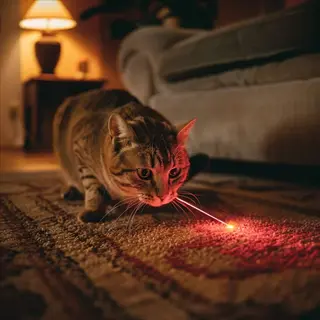
Interactive Laser Toys
- Red dot projection stimulates hunting instincts without physical contact requirements
- Always end sessions with tangible reward like treats to prevent frustration buildup
- Use irregular movement patterns to mimic prey behavior and maintain interest levels
- Limit sessions to 10-15 minutes (0.16-0.25 hours) to avoid overexertion and stress responses
- Choose automatic rotating bases for independent play when owners are unavailable
- Never shine directly in eyes and select pet-safe class II laser products exclusively
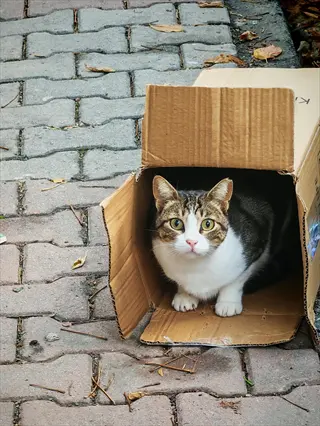
Comfortable Hiding Boxes
- Enclosed spaces satisfy instinctual need for security and visual barriers effectively
- Line with faux fleece or thermal material for temperature regulation and comfort
- Cut multiple entry/exit points to prevent feeling trapped during anxiety episodes
- Place in quiet corners away from household traffic patterns and noisy appliances
- Rotate boxes seasonally with different scents like lavender for novelty maintenance
- Choose cardboard for disposable options or wood for permanent installation solutions
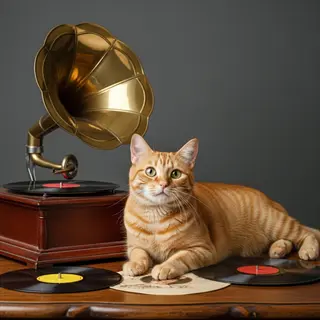
Soothing Music for Cats
- Species-specific compositions use purring frequencies and suckling sounds for calming
- Play at consistent volume below 60 dB to avoid auditory stress responses
- Stream through smart speakers during work hours for consistent environmental enrichment
- Classical music or harp melodies show significant stress reduction in clinical studies
- Introduce gradually during calm periods to create positive auditory associations first
- Use sleep playlists overnight to mask urban noise pollution in residential areas
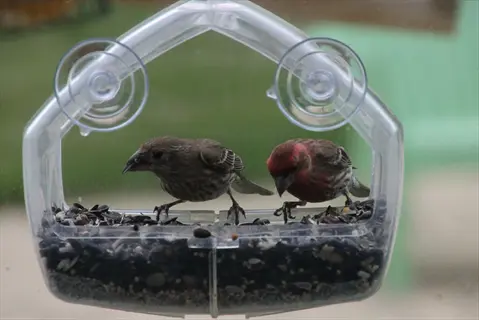
Window Bird Feeders
- Visual stimulation provides entertainment without direct interaction requirements safely
- Place suction-cup models at cat eye-level for optimal viewing angles and comfort
- Refresh seeds regularly to maintain bird activity throughout daylight hours consistently
- Combine with perch platforms for comfortable observation sessions from indoors
- Clean weekly with vinegar solution to prevent bacterial contamination issues effectively
- Position away from direct sunlight to avoid overheating during summer months
Approaching a Hiding Cat Correctly
Your first tool for finding a hiding cat is passive observation. Sit quietly 3-5 feet (0.9-1.5 meters) away from the area or room where the hiding cat is likely to hang out, without staring directly at it. You are showing her that you are not a threat by avoiding direct eye contact. Bring along a book or other quiet activity. Wait 15-20 minutes. Your calm presence will help calm a hiding cat and give them a safer feeling.
Use a gentle monotone, such as human whisper therapy, for cats. Speak softer than actual conversations. Repeat familiar words like 'treat' or 'dinner'. This creates repeatable sound patterns. Cats associate your calm voice with safety. This reassures them without physical contact.
Treat-luring works because cats are highly motivated by food. Set out high-value treats (such as tuna) every 12 inches (30 cm) in front of you. Use a long spoon so as not to invade their space. Wait 5-10 minutes in between placements. This allows curiosity to build up gradually. It plays off of their instinct to forage.
If your cat flattens their ears or thumps their tail, stop what you're doing. Go back to where you were. The cat feels threatened. Give it space. After a 2-3 hour cooldown, try again. Forcing engagement only increases fear. Trust is built over time with patience and persistence.
Passive Observation Phase
- Sit quietly 3-5 feet (0.9-1.5 meters) from hiding spot without direct eye contact
- Remain still for 15-20 minutes (0.25-0.33 hours) to demonstrate non-threatening presence
- Bring quiet activities like reading to avoid sudden movements that may startle
Voice Calming Method
- Speak in soft monotone using familiar words like treat or dinner consistently
- Keep volume below 50 dB (normal conversation level) to prevent auditory stress
- Recite repetitive phrases to create predictable sound patterns for reassurance
Treat Luring Strategy
- Place high-value treats like tuna or chicken every 12 inches (30 cm) leading from hiding spot
- Use long-handled spoon to extend reach without invading personal space boundaries
- Wait 5-10 minutes (0.08-0.16 hours) between treat placements for gradual curiosity building
Toy Engagement Approach
- Dangle wand toys 18-24 inches (45-60 cm) away using slow side-to-side movements
- Choose feather attachments over bells to minimize noise-related anxiety triggers
- Retract toy gradually once interest shown to encourage following behavior
Boundary Respect Protocol
- Abandon approach immediately if ears flatten or tail thumping occurs
- Retreat to original 5-foot (1.5-meter) distance if hissing/growling resumes
- Reschedule interaction after 2-3 hours (120-180 minutes) cooldown period
Creating a Safe Space
Permanent safe spaces are best in stable situations, such as closed cat beds or perch-like wall-mounted ones. Temporary situations require temporary safe spaces. These include easy-to-use cat carriers or cardboard boxes. Both sets of spaces should be available for the stressed-out cat.
Familiar smells put cats at ease. Put certain used clothes in their designated storage areas. Here they connect to their territorial security instincts. Cats will mark a favourite spot with facial pheromones when they feel secure in an area, and your particular scent, which gives safety signals, is boosted. Weekly swapping of these items enhances their effectiveness.
Imagine a multi-tiered zone like an apartment building for cats. Each level serves a specific purpose: sleeping, observing, hiding. Provide a variety of platforms at various heights. A minimum of 2x2 feet (0.6x0.6 meters) per platform is perfect. Thus designed, they can indulge their innate desire for vertical territory.
Strategic placement of resources is key. Feeders should be put at least 3 feet (0.9 m) from litter boxes. Beds should be placed in quiet corners away from doors. Play areas should be placed far from rest areas, as this creates stress. By doing this, your cat will feel more secure immediately.
Recognizing When to Visit the Vet
Your cat's hiding is a method of call in sick. Just like people don't go to work when they feel ill, neither do cats. Due to their discomfort, cats hide. If this activity lasts more than 24-48 hours (1-2 days), it indicates potential health problems that need to be addressed. It can signal pain, infection, or chronic disease that needs to be diagnosed.
Emergency symptoms require a visit to the vet right away. This can mean nausea (occurring more than three times a day), fever over 103°F, or severe limping. Emergencies happen suddenly and involve acute conditions, such as injuries or infections. Never wait for this type of symptom to appear.
Keep an eye on mild problems at home for a while. This would include slight appetite loss (less than 48 hours) or possible hidden stress. However, be cautious of the possibility of worsening. Behavioral changes such as hiding more than usual might be related to a potential medical problem. Lethargy means there may be arthritis. Hissing could be related to dental pain.
Use home visits within 24 hours for high-risk indicators. These include hiding for more than 72 hours with no improvement or any indicator and refusing food. Early intervention prevents minor problems from becoming major emergencies. Trust your feelings about your cat's needs.
Why Cats Hide: Top Reasons
Cats hide due to profound evolutionary survival instincts. In the wild, hiding from other animals was a protective adaptation to the threat of predation. In the present age, loud noises, unfamiliar people, and other stimuli trigger this instinctual response, which is rooted in distant ancestral experiences. Your cat is not being obstreperous. He is acting on the genetic programming that protected his ancestors over the centuries from concealment and distraction.
Territorial tension is the feline equivalent of "human home invasion anxiety." New pets in their 500 sq ft (46 m²) territory incite panic. The outdoor cats near the windows elicit similar reactions. This is not jealousy but a defense mechanism to sense danger to their territory.
Differences in breed impact tendencies to hide. For example, vocal Siamese may hide less than territorial Maine Coons. Persian cats are more likely to retreat from disruptions. You can think of the cat's experiences in terms of its genetic blueprint. Their stress response is affected by changes in the household environment.
Health-related issues trigger the defense mechanism of 'Hide to Survive'. Dental pain or infections may create a perception of vulnerability in cats. Life changes caused by moving create problems with scent maps. Poor socialization can make cats unprepared for stress, such as surprises. Be aware of these trigger points. They will tell you the reason for Hiding.
Fear/Anxiety Triggers
- Sudden loud noises exceeding 85 dB (e.g., vacuums, thunderstorms)
- New people/pets invading 500 sq ft (46 m²) territory range
- Routine changes disrupting feeding/sleep cycles by 2+ hours
Health Issues
- Dental pain scoring ≥4/10 on feline pain scale (symptoms: lip quivering, head tilting)
- Undiagnosed infections causing fevers of 103°F+ (39.4°C+)
- Arthritis in senior cats limiting mobility to 10-15 feet (3-4.5 m) ranges
Territorial Stress
- New furniture occupying >25% of core territory space
- Outdoor cats visible within 10 feet (3 m) of windows/doors
- Resource competition in multi-cat households (>1 cat per 500 sq ft/46 m²)
Poor Socialization
- Limited human contact during 2-7 week critical socialization window
- Single-environment upbringing lacking novel sound/texture exposure
- Negative vet/groomer experiences creating lasting fear associations
Life Changes
- Moving homes disrupting scent-marked territories
- New baby adding 70+ dB crying sounds daily
- Work schedule changes altering feeding times by 3+ hours
Pregnancy Instincts
- Unspayed females seeking nesting spots 1-2 weeks pre-birth
- Temperature-controlled spaces maintaining 85-90°F (29-32°C)
- Isolated locations >10 feet (3 m) from household activity centers
Aging Vulnerabilities
- Cognitive decline causing disorientation in spaces >400 sq ft (37 m²)
- Reduced hearing/vision increasing startle responses below 5 feet (1.5 m)
- Joint pain limiting mobility to single-floor access
5 Common Myths
Cats hide because they're disobedient or trying to ignore their owners intentionally
Hiding is an instinctual fear response, not disobedience. When cats feel threatened by loud noises, unfamiliar people, or environmental changes, their natural survival mechanism triggers retreat behaviors. This involuntary reaction stems from evolutionary wiring where concealment provided safety from predators, not from any desire to disregard human companionship or express willful defiance of owner expectations.
Cats are purposely ignoring their owners for not being with them or any minor infraction
Felines do not have the advanced cerebral spectra necessary for punishment behavior. Hiding would be an automatic physiological stress response to perceived dangers, not retaliation responses. What happens is that when humans leave cats behind, there is an emotional state of anxiety due to broken routine and loss of territory which are both anxiety provoking events. This event creates tension which creates a cerebral cortical release of corticoids.great enough to cause a behavioral response based on instinctive self-protective concealment. However, this is an instinctive physiological response and bears no relationship to human concepts of punishment, nor is it a means of human emotional manipulation.
Compelling an afraid cat out of its safe zone fosters the faster eradication of anxiety
Forced exposure greatly augments anxiety, eliciting the fight-or-flight reflex. While humans forcibly remove cats from hiding places, cortisol levels shoot up, making for a threatening situation that adds to future anxiety. Effective solutions consist of building security into the environment, enabling the cats to come forth voluntarily when the nervous system has been calmed through pheromonal diffusion, routine predictability, and non-threatening co-inhabiting procedures.
Only sick or unhealthy cats hide routinely, so there is invariably some medical disease present whenever hiding is habitual
Although disease may be responsible for hiding, it is very common for conditions not due to disease to be responsible for this which may be quite innocuous such as invasion of territory, changes in routine or environmental stimuli which may be excessive. Healthy cats may hide because of fear of firecrackers, introduction of a new pet, or renovation of quarters. Whenever a cat hides a veterinary diagnosis should be obtained to rule out pathology, but the fact is that the cause in 60 per cent of the cases of chronic hiding in clinically healthy cats is due to environmental stimuli.
If owners simply wait long enough, the hiding behavior will spontaneously resolve itself without any intervention
Prolonged hiding strengthens the neural pathways responsible for augmented stress responses in the future. If structured counterconditioning is not instituted via alterations in the environment, desensitization techniques, and augmentations of security, hiding behaviors usually become strengthened. Professional intervention becomes necessary when the avoidance symptoms persist for longer than 72 hours since chronic stress will produce impairment of the immune system, as well as lasting behavioral changes requiring specialized rehabilitative protocols.
Conclusion
Remember, hiding is purely typical feline interaction; not disobedience. Your cat is not naughty. They express discomfort through this behavior. I have helped many cat owners see the situation from a different perspective about their cat. It changes frustration into understanding with compassion. And, this is the foundation for trust.
Put what you've learned into practice: create safe places, use calming techniques, respect boundaries. These solutions are tied together, since they treat different root causes of hiding. Make one change today. Small changes often create huge results in your cat's confidence.
Patience and observance are your greatest assets. Observe subtle changes in behavior. Track leaping behavior in a simple journal. Give solutions time to take effect. Rushing creates setbacks. A consistently calm presence in time creates a sense of security.
Recognizing these behaviors deepens your relationship dramatically. You become your cat's most trusted friend. This friendship turns living together into real companionship. Your endeavors bring a happier and healthier life together. That reward is worth all the patient moments.
External Sources
Frequently Asked Questions
Why do cats suddenly start hiding?
Cats may hide suddenly due to environmental stressors like new pets or loud noises, health issues causing discomfort, or territorial disruptions. Changes in routine or unfamiliar scents can also trigger this instinctual survival behavior.
When should I be concerned about hiding behavior?
Seek veterinary care if hiding persists beyond 72 hours with symptoms like appetite loss, vomiting, or lethargy. Immediate attention is needed for limping, fever over 103°F, or visible pain responses.
Do cats hide when feeling unwell?
Yes, hiding often indicates illness or pain as cats instinctively conceal vulnerability. Common triggers include dental issues, infections, or chronic conditions like arthritis requiring professional diagnosis.
How can I safely approach a hiding cat?
Effective approaches include:
- Sit quietly 3-5 feet away without direct eye contact
- Use soft, repetitive verbal reassurance
- Place high-value treats leading to their location
- Never force physical contact or pull them out
What natural methods calm anxious cats?
Non-medical solutions include:
- Pheromone diffusers near hiding zones
- Catnip or silvervine for temporary relaxation
- Designated safe spaces with enclosed beds
- Soothing music with species-specific frequencies
Can environmental changes cause hiding?
Yes, disruptions like moving furniture, new people, or altered feeding schedules can trigger hiding. Cats rely on predictable territory and may conceal themselves when their security feels threatened.
How long might a stressed cat hide?
Duration varies from hours to days depending on stress severity. Most cats emerge within 48 hours with proper environmental support. Seek help if hiding exceeds 72 hours without improvement.
Do cats isolate when nearing end-of-life?
Terminally ill cats often seek solitude, but isolation doesn't always mean dying. Differentiate by checking for extreme weakness, labored breathing, or complete refusal of food/water alongside hiding behavior.
What safe space elements reduce hiding?
Essential components include:
- Enclosed beds in quiet corners
- Vertical perches for observation
- Multi-exit hideaways for escape routes
- Owner-scented bedding for familiarity
Can cat hiding indicate emotional distress?
Yes, chronic hiding often signals anxiety from poor socialization, past trauma, or ongoing stress. Behavioral signs like excessive grooming or vocalization typically accompany emotionally triggered concealment.
